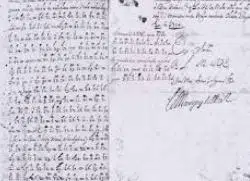The adjective cipher refers to something whose writing is carried out with figures : that is, with signs that are used to represent numbers or that can only be understood when the corresponding key is known.
 Encryption is a common method in cryptography (the technique of writing messages in code ). What encryption means, in this case, is an encoding of the content of the message, protecting it. In this way, only those who know the key to decoding it can understand the content.
Encryption is a common method in cryptography (the technique of writing messages in code ). What encryption means, in this case, is an encoding of the content of the message, protecting it. In this way, only those who know the key to decoding it can understand the content.
Cryptography, specifically, uses an encryption algorithm that makes the message incomprehensible and a key that allows, precisely, it to be understood. The plaintext , through the encryption process, is converted into a cryptogram ( ciphertext ).
Depending on how the algorithm is used, it is possible to differentiate between block encryption (the message is divided into blocks of equal length and then encryption is carried out) and stream encryption ( bit by bit). Depending on the properties, on the other hand, we talk about isolated key encryption , identity-based encryption , malleable encryption , secure forward encryption , deniable encryption and others.
However, the list of encryption types that exists is really extensive:
-IDEA encryption, which is based on the existence of eight rounds of identical encryption except for the subkeys used.
-RSA encryption, which is characterized because the user has two encryption keys: one that is public and another that is private.
-Blowfish encryption, which uses decimals of “pi”.
-Pigpen cipher, which consists of monoalphabetic substitution in various forms. It must be stated in this sense that it was widely used by the Templars when it came to ensuring the safety of all the pilgrims heading towards the Holy Land.
-Caesar Cipher. It receives this name because it was Julius Caesar who used it. It consists of moving the plain text characters three spaces to the right.
-Vernam Cipher, which has this name because it was created by engineer Gilbert Sandford Vernam in the early 20th century. He worked for the company AT&T Bell Labs and formed this system that consisted of combining a random data stream of the same size to shape what was an encrypted text.
In addition to all of the above, we have to emphasize that during World War II a machine called Enigma was created that could be used both to encrypt messages and to decrypt them. It was patented in 1918 by a German company although it was during the aforementioned war when it achieved its greatest splendor.
In the field of music , the use of signs to express a sound phenomenon is called encryption. In other words, encryption involves using letters or numbers instead of musical notes. The English cipher (also known as the American cipher or Anglo-Saxon cipher ), for example, uses the following equivalences between letters and notes: A = A , B = Si , C = Do , D = Re , E = Mi , F = Fa and G = Sun.
